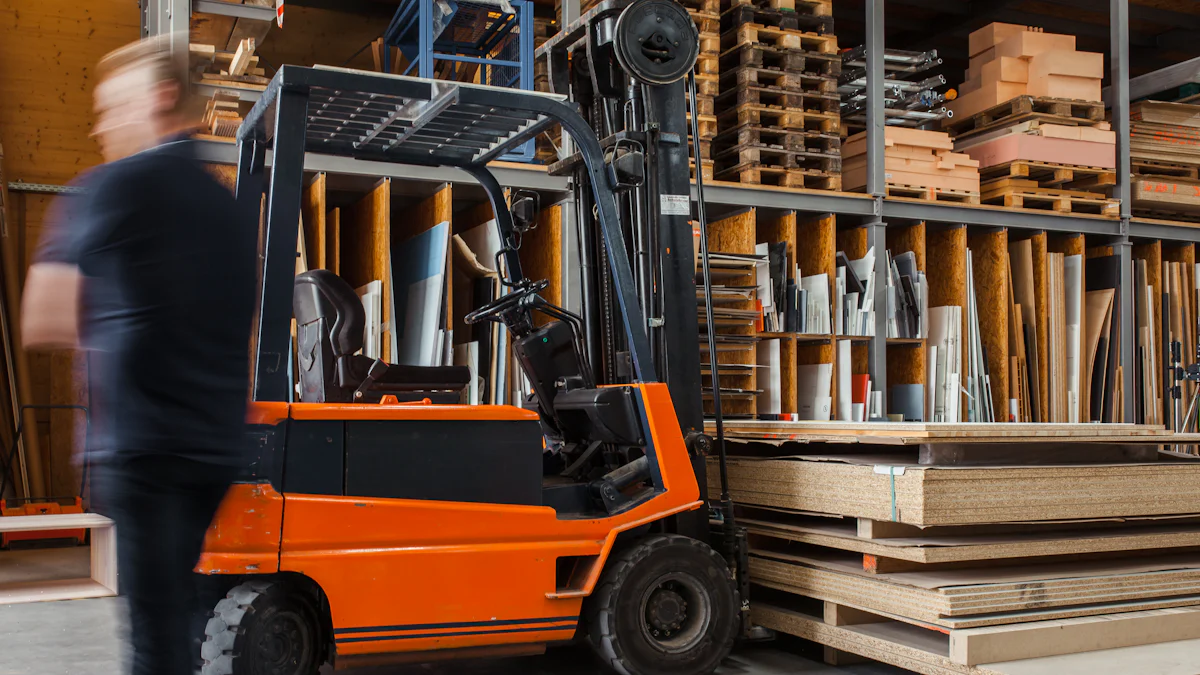
Selecting the appropriate pallet jack is a critical decision that can significantly impact the efficiency and safety of your operations. By choosing the right equipment, businesses can streamline their logistics processes, reduce manual handling, and enhance overall productivity. This blog provides an in-depth exploration of different types of pallet movers, key features to consider, and essential factors for selection. Understanding these aspects will empower you to make informed decisions tailored to your specific needs.
Types of Pallet Movers
When it comes to pallet movers, businesses have a variety of options to choose from based on their specific needs and operational requirements. Understanding the distinct features and applications of each type is crucial for making an informed decision that aligns with your logistics processes.
Hand Pallet Movers
Hand pallet movers, also known as pallet jacks, are manual handling equipment commonly used in warehouses, factories, and retail spaces. These versatile tools offer a range of features that cater to various material handling tasks.
Features of Hand Pallet Movers:
- Adaptability: Hand pallet movers are designed to accommodate different pallet sizes and types, providing flexibility in handling various loads.
- Maneuverability: With easy-to-use steering mechanisms, hand pallet movers allow operators to navigate tight spaces and aisles efficiently.
- Durability: Built with robust materials, hand pallet movers can withstand daily use in demanding industrial environments.
Applications of Hand Pallet Movers:
- Warehouses: Hand pallet movers play a vital role in transporting goods within warehouses, facilitating the movement of inventory from storage areas to shipping docks.
- Retail Spaces: In retail settings, hand pallet movers streamline restocking processes by enabling employees to move merchandise safely and swiftly.
- Manufacturing Facilities: Hand pallet movers aid in the efficient transfer of raw materials and finished products along assembly lines, enhancing production workflows.
Semi-Electric Pallet Movers
Semi-electric pallet movers combine manual operation with powered assistance, offering enhanced efficiency for medium-duty material handling tasks. These versatile machines bridge the gap between manual and fully electric models.
Features of Semi-Electric Pallet Movers:
- Hybrid Design: Semi-electric pallet movers feature a combination of manual steering and electric lifting capabilities for optimal performance.
- Enhanced Productivity: By reducing operator strain during lifting and maneuvering tasks, semi-electric models boost overall productivity levels.
- Cost-Effective: Compared to fully electric options, semi-electric pallet movers provide a budget-friendly solution without compromising on functionality.
Applications of Semi-Electric Pallet Movers:
- Wholesale Distribution Centers: Semi-electric pallet movers are ideal for handling bulk orders and moving heavy loads efficiently in distribution facilities.
- Storage Facilities: These versatile machines support inventory management operations by simplifying the movement of goods within storage areas.
- Commercial Settings: In commercial environments such as supermarkets or hardware stores, semi-electric pallet movers aid in stock replenishment activities with ease.
Electric Pallet Movers
Electric pallet movers represent the pinnacle of motorized material handling equipment, offering advanced features tailored for high-volume operations requiring precision and power. These robust machines are designed to handle heavy loads with ease.
Features of Electric Pallet Movers:
- Battery-Powered Operation: Electric pallet movers run on rechargeable batteries, providing consistent power output for continuous usage throughout the day.
- High Load Capacity: With impressive weight-bearing capabilities, electric models can lift and transport substantial loads effortlessly.
- Advanced Controls: Equipped with intuitive control panels, electric pallet movers offer precise handling for intricate material transport tasks.
Applications of Electric Pallet Movers:
- Large Warehouses: Electric pallet movers excel in vast warehouse settings where rapid movement of goods is essential for streamlined logistics operations.
- Manufacturing Plants: These powerful machines are indispensable in manufacturing facilities where heavy materials need to be transported safely across production floors.
- Logistics Centers: In distribution hubs and fulfillment centers, electric pallet movers enhance order fulfillment processes by ensuring swift and accurate material transfers.
Key Features

Load Capacity
When selecting a pallet mover, one of the critical aspects to consider is the load capacity it can handle. The importance of load capacity cannot be overstated, as exceeding the weight limit can lead to operational inefficiencies and safety hazards. To determine your load capacity needs, assess the heaviest loads your business typically handles and choose a pallet mover that can comfortably manage those weights.
- Opt for a pallet mover with a load capacity slightly higher than your maximum load requirements to ensure optimal performance.
- Consider future growth projections when evaluating load capacity to accommodate potential increases in workload.
Lifting Height
The lifting height of a pallet mover plays a significant role in its usability within your operations. Understanding the importance of lifting height is crucial for efficient material handling processes. To determine your lifting height needs, assess the vertical clearance required for loading and unloading tasks, taking into account any elevated storage areas or shelving units.
- Choose a pallet mover with a lifting height that aligns with your warehouse layout and storage configurations.
- Factor in any height restrictions in your facility to ensure seamless maneuverability during material transport.
Fork Height
Another essential feature to consider when choosing a pallet mover is the fork height. The importance of fork height lies in its compatibility with different pallet sizes and stacking requirements. To determine your fork height needs, evaluate the standard dimensions of the pallets used in your operations and select a pallet mover with adjustable fork heights if necessary.
- Opt for a pallet mover with versatile fork height settings to accommodate various pallet dimensions.
- Ensure that the fork height allows for easy insertion and retrieval of pallets during loading and unloading processes.
In comparing different websites’ guidance on selecting the right pallet jack based on load capacity, lifting height, and fork height, it becomes evident that these factors are paramount in choosing an appropriate equipment model. Factors such as maneuverability, weight capacity, fork length, and operational requirements are emphasized across various sources.
Factors to consider when choosing a hand pallet truck include load capacity, fork length, build quality, control features, and customer reviews. Selecting a truck with a weight capacity higher than the maximum load is recommended for safety and efficiency according to key differences highlighted by industry experts.
Insights from AM Industrial Group underscore the importance of considering lift height and weight capacity when selecting a pallet jack for stacking pallets or placing loads on shelves or racks. These considerations align with industry best practices aimed at optimizing material handling processes efficiently.
AJ Products UK mentions the availability of different pallet truck types catering to various pallet sizes and handling needs. This diversity ensures businesses can find tailored solutions that meet their specific operational requirements effectively.
Considerations for Selection
In the realm of pallet movers, selecting the most suitable equipment involves a meticulous evaluation of various factors to ensure optimal performance and operational efficiency. The working environment, application needs, and budget constraints play pivotal roles in determining the ideal pallet mover for your business.
Working Environment
Indoor vs. Outdoor Use
When contemplating the choice of a pallet mover, one must first consider the distinct requirements posed by indoor and outdoor environments. Indoor spaces necessitate equipment that can maneuver through narrow aisles and tight corners with ease, ensuring seamless material transport within confined areas. On the other hand, outdoor settings demand pallet movers equipped to withstand varying weather conditions and rough terrains, guaranteeing reliable performance in open spaces.
Environmental Factors to Consider
In addition to indoor-outdoor distinctions, environmental factors such as temperature fluctuations and moisture levels should be taken into account when selecting a pallet mover. Ensuring that the chosen equipment is resilient to environmental challenges will prolong its lifespan and maintain operational efficiency under diverse conditions.
Application Needs
Specific Industry Requirements
Each industry sector presents unique challenges and demands specific functionalities from pallet movers to optimize material handling processes. Understanding the specific requirements of your industry enables you to tailor your equipment selection accordingly. For instance, industries with high-volume operations may benefit from electric pallet movers due to their enhanced load-bearing capacities and precision controls.
Customization Options
The availability of customization options allows businesses to adapt pallet movers to their precise operational needs effectively. Custom features such as specialized fork lengths or ergonomic handle designs can enhance user experience and streamline material handling tasks based on individual requirements. By exploring customization possibilities, businesses can maximize the utility of their pallet movers in alignment with their operational workflows.
Budget Constraints
Cost vs. Value
Navigating budget constraints while ensuring optimal value from your pallet mover investment requires a strategic approach that balances upfront costs with long-term benefits. While cost-effective solutions are appealing, prioritizing value ensures that the selected equipment aligns with your operational requirements without compromising on quality or performance.
Long-term Investment Considerations
Viewing the acquisition of a pallet mover as a long-term investment underscores the importance of durability, reliability, and scalability in equipment selection. Evaluating maintenance costs, service agreements, and potential upgrades over time enables businesses to make informed decisions that support sustained operational efficiency and productivity.
In considering these essential aspects—working environment dynamics, application-specific needs, and budgetary considerations—you can navigate the diverse landscape of pallet movers confidently. By aligning your selection criteria with your business objectives and operational requirements, you pave the way for enhanced logistics processes and streamlined material handling operations.
Selecting the appropriate pallet mover is paramount for optimizing operational efficiency and ensuring workplace safety. Evaluating key factors such as load capacity, lifting height, and fork height enables businesses to make informed decisions tailored to their specific needs. By considering working environment dynamics, application-specific requirements, and budget constraints, organizations can enhance their material handling processes effectively. Looking ahead, continuous advancements in pallet mover technology offer opportunities for future developments that align with evolving industry demands and operational challenges.
Post time: Jun-18-2024
